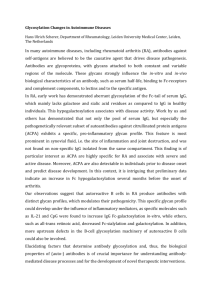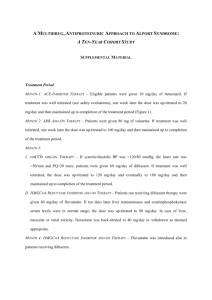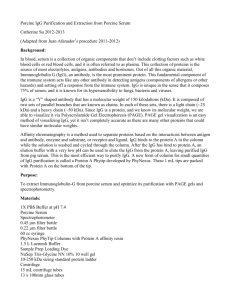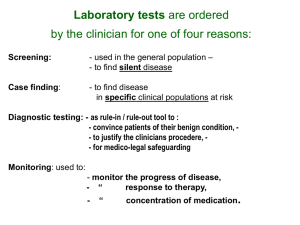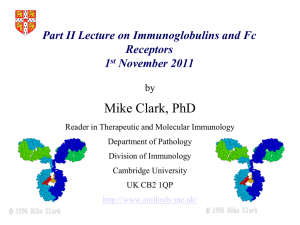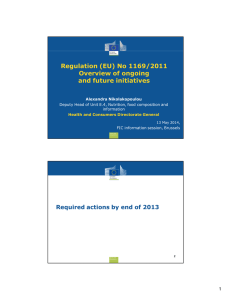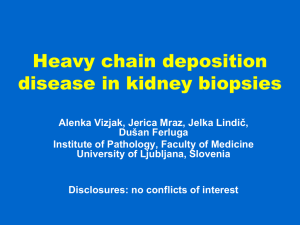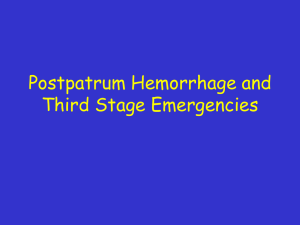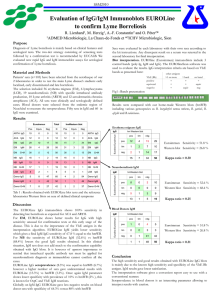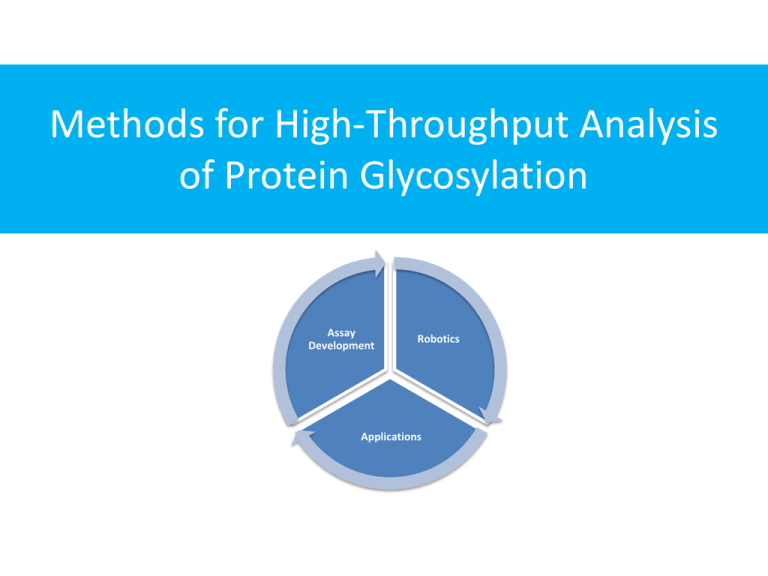
Methods for High-Throughput Analysis
of Protein Glycosylation
Assay
Development
Robotics
Applications
Development of an automated glycomics platform
Cell culture sample,
serum
1
Protein binding
1
Protein denaturation
2
Washing & elution
2
Alkylation
3
Solvent removal
3
4
(1)
(2)
(3)
(4)
1
Glycan capture on solid
support
2
Washing & glycan release
3
Fluorescent labelling
4
Labelling clean-up
1
Integration and quantification
2
Data analysis and visualisation
Glycan release
Glycan elution
Cell secretome glycomics
Whole serum glycomics
IgG glycomics
PGC cleanup
Anal. Chem. 2013, 85, 8841-8849
IgG glycomics workflow – 2AB labelling
Anal. Chem. 2013, 85, 8841-8849
Glycan sample clean-up using solid supports
Anal. Chem. 2008, 80, 1094-1101
Importance of sample clean-up for 2AB labelling
No clean-up
4.00
4.50
5.00
5.50
6.00
6.50
7.00
7.50
8.00
8.50
9.00
9.50
10.00
10.50
11.00
Minutes
11.50
12.00
12.50
13.00
13.50
14.00
14.50
15.00
15.50
16.00
16.50
17.00
17.50
18.00
Development of an IgG N-Glycosylation Protocol
3.00
Robotics
Key challenges:
– Reproducibility
– Nonspecifically bound glycoproteins on solid supports
– Recovery of small glycans from beads
– Bead aggregation
– Reagent consumption
– Incubation times
– General robotics issues (e.g. automatic error recovery overnight)
Assay
Development
Data
analysis
3.50
4.00
4.50
5.00
5.50
6.00
6.50
7.00
7.50
8.00
8.50
9.00
9.50
10.00 10.50 11.00 11.50 12.00 12.50 13.00 13.50 14.00 14.50 15.00 15.50 16.00 16.50 17.00 17.50 18.00
Minutes
IgG GPA Comparison
IgG CV Comparison
PNGase F time course
Serum glycomics program
4.00
IGB
18.3 %
19.3 %
4.50
5.00
5.50
6.00
6.50
7.00
7.50
Robot
8.00
8.50
9.00
9.50
10.00 10.50 11.00 11.50 12.00 12.50 13.00 13.50 14.00 14.50 15.00 15.50 16.00 16.50 17.00 17.50 18.00 18.50 19.00 19.50 20.00 20.50 21.00 21.50 22.00
Minutes
Reproducibility – Robot (8 replicates)
4.00
4.50
5.00
5.50
6.00
6.50
7.00
7.50
8.00
8.50
9.00
9.50
10.00 10.50 11.00 11.50 12.00 12.50 13.00 13.50 14.00 14.50 15.00 15.50 16.00 16.50 17.00 17.50 18.00 18.50 19.00 19.50 20.00 20.50 21.00 21.50
Minutes
Reproducibility – IGB (8 replicates)
4.50
5.00
5.50
6.00
6.50
7.00
7.50
8.00
8.50
9.00
9.50
10.00 10.50 11.00 11.50 12.00 12.50 13.00 13.50 14.00 14.50 15.00 15.50 16.00 16.50 17.00 17.50 18.00 18.50 19.00 19.50 20.00 20.50 21.00 21.50 22.00
Minutes
40.0
35.0
GP1
GP2
GP3
GP4
GP5
GP6
GP7
GP8
GP9
GP10
GP11
GP12
GP13
GP14
GP15
GP16
GP17
GP18
GP19
GP20
GP21
GP22
GP23
GP24
GP25
GP26
GP27
GP28
GP29
GP30
GP31
GP32
GP33
GP34
GP35
GP36
GP37
GP38
GP39
GP40
GP41
GP42
GP43
GP44
GP45
GP46
Reproducibility – CVs
45.0
IGB: 14 peaks > 10%
Robot: 7 peaks > 10%, 60% of
peaks have better CVs than IGB
30.0
IGB
25.0
serum-optimised clean-up
20.0
15.0
10.0
5.0
0.0
Comparison of different approaches
Time required for
the preparation of
96 samples
In-gel block
method
GlycoBlot
GlycoPrep
NIBRT
platform
3 days
22 h
6h
14 h
(starting from isolated
glycoprotein)
(whole serum glycans)
Consumables cost
per sample
Throughput
Sample matrix
Automation
Commercial
availability
52 EUR
62 EUR
96
96
96
96
Serum, plasma,
pure glycoprotein
Serum, plasma,
pure glycoprotein
potentially
SweetBlot
Cell culture
supernatant, pure
glycoprotein
AssayMap Bravo
Serum, plasma,
pure glycoprotein,
tissue
Hamilton StarLet
Sumitomo Bakelite
Prozyme/Agilent
IgG glycomics workflow – 2AB labelling
Anal. Chem. 2013, 85, 8841-8849
Comparison of different approaches
Sample
preparation
time
GlycoBlot
GlycoPrep
22 h
6h
<2h
3h
4h
(starting from
isolated
glycoprotein)
Consumables
cost per
sample
Throughput
52 EUR
62 EUR
96
96
Sample matrix
Serum, plasma,
pure
glycoprotein
Cell culture
supernatant,
pure
glycoprotein
AssayMap
Bravo
Automation
Quick labelling platform
(under development)
SweetBlot
competitive
1-5
96
384
Serum, affinity Serum, affinityAffinitypurified
purified
purified
protein,
protein (80 ug protein (15 ug
Skin tissue
IgG)
IgG)
No
Yes
96-well quick labelling – human IgG
2.00
2.50
3.00
3.50
4.00
4.50
5.00
5.50
6.00
6.50
7.00
7.50
Minutes
8.00
8.50
9.00
9.50
10.00
10.50
11.00
11.50
12.00
12.50
13.00
384-well quick labelling – IgM Glycoprofile
2.00
2.50
3.00
3.50
4.00
4.50
5.00
5.50
6.00
6.50
7.00
7.50
8.00
8.50
Minutes
9.00
9.50
10.00
10.50
11.00
11.50
12.00
12.50
13.00
13.50
14.00
14.50
15.00
384-well quick labelling – IgA Glycoprofile
2.00
3.00
4.00
5.00
6.00
7.00
8.00
9.00
10.00
11.00
12.00
Minutes
13.00
14.00
15.00
16.00
17.00
18.00
19.00
20.00
21.00
22.00
Project Portfolio
2012
2012-2013
Q1/2013
Q2/2013
• Serum glycomics assay development
• Pancreas cancer study (R. Saldova + E. Kure)
• IgG glycomics assay development
• JIA/UI (with P. Nigrovic)
• Glycosylation in animal health - Endometritis study
• Glycosylation in animal health - Pregnancy study
Q2/2013
• Improvement of serum glycomics assay
• CRC – first large-scale study (GlycoBioM)
Q3/2013
• Breast cancer study (R. Saldova, V. Haakensen), TB infection study
• High-throughput assay development + skin glycomics (R. Duke)
Application
Glycosylation in Uterine Health
Uterine disease: ‘Microbial infection and/or pathological inflammation of the uterus’
Humans: Pelvic Inflammatory Disease (PID): Often STIs, causes over 100,000 women to
become infertile in the US each year; no single test has adequate sensitivity and specificity
to diagnose.
Bovine: Metritis/Endometritis.
Uterine bacteriology
Uterine Pathogens
Potential pathogens
Opportunist Contaminants
Escherichia coli
Trueperella pyogenes
Fusobacterium necrophorum
Fusobacterium nucleatum
Prevotella spp
Acinetobacter spp
Bacillus licheniformis
Enterococcus faecalis
Heamophilus somnus
Mannhiemia haemolytics
Pastuerella multocida
Peptostreprococcus spp
Staphylococcus aureus
Streptococcus uberis
Aerococcus viridans
Clostridium butyricum
Clostridium perfringens
Corynebacterium spp
Enterobacte aerogenes
Klebsiella pneumoniae
Micrococcus spp
Providencie rettgeri
Providencia stuartii
Proteus spp
Proprionobacterium granulosa
Staphylococcus spp (coag -)
A-haemolytic Streptococcus
Streptococus acidominimus
© R Paralan
Uterine disease and its impact on the dairy industry
• Diagnosis of uterine infection typically occurs after clinical observation of disease
between 2 and 5 weeks after calving.
• Damage to animal health, productivity, and fertility has already occurred.
• Sought: Reliable early test to accurately diagnose uterine disease in the first few days
after calving
• enable early therapeutic intervention and development of management strategies to
reduce the substantial economic and welfare impacts.
- Do healthy cows and cows with uterine infection
differ in IgG glycosylation?
- Can IgG glycosylation be exploited as a biomarker?
calving
blood sampling and uterine health assessment
prepartum
~10 days
day 7 pp
• Health monitoring
• Ultrasonography
• Fertility monitoring
day 14 pp
day 21 pp
• 98 subjects: clean, endometritis, metritis
Peak assignments
1
3.00
2
3
4 5 6
4.00
7
5.00
8
9
10 11
6.00
12
13 14 15
7.00
16
17 18
8.00
19
20
9.00
21
10.00
22
23
24
11.00
Minutes
12.00
25
26
13.00
27
28
14.00
29
15.00
30
16.00
31
17.00
18.00
19.00
20.00
Representative glycosylation differences
healthy
endometritis
Representative glycosylation differences
healthy
endometritis
Fucosylation Ratios. Day 0
Fucosylation Ratios. Day 7
Fucosylation Ratios. Day 14
Results from large-scale study
Determining predictive power of glycans
P-values and AUC Day 14
Conclusions
• Glycans are promising candidates for uterine disease classification
• Fucosylation is a strong marker
Future aims
Animal health
• Set-up automated high-throughput assay for fucosylation analysis
Assay development
• Validation of HT quick assay
• Labelled dextran ladder
GlycoBase Update – Basic Structure
Collaborations
Academic
Projects
NIBRT
Contract
Research
Private Clients
Data
Review
Process
GlycoBase
GlycoBase Update - Overview
Unique Structures
Individual Measurements
Glycans with LC data
Number of Profiles
Replicate Sets
Digest Panels
13991
11023
846
827
123
63
GlycoBase – New Features
•
•
•
•
•
•
•
New Collections Available
Sign-up free application
Major Collections Reviewed
Digest Panel information
In-silico Digest (GlycoDigest)
New Searching Functionality
Application Programming Interface
(API)
New Collections
• CE Data:
• Heptaglobin
• IgG
• Standards
• RNAse B
• Transferrin
• UPLC
• Milk oligosaccharide:
• Cow, Dromedary Camel, Goat, Horse, Pig, Sheep
• Human Serum, IgG
• HPLC
• Royle 2008 Paper
• RP-UPLC
• Human IgG
Graphical Reporting
GlycoDigest
Available Enzymes: CBG, NVS, XMM, JBH,
XMF, ABS, NAN1, BTG, AMF, BKF, JBM, GUH,
SPG
IgG Structural Assignments
GP 1
2
3
4
5 6
7
8 9 10 11 12 13
14 15 16
17 18 19
20
21
22
23
24
25
26
27 28
Glycosylation in Animal Health – Small Scale Pilot Study

